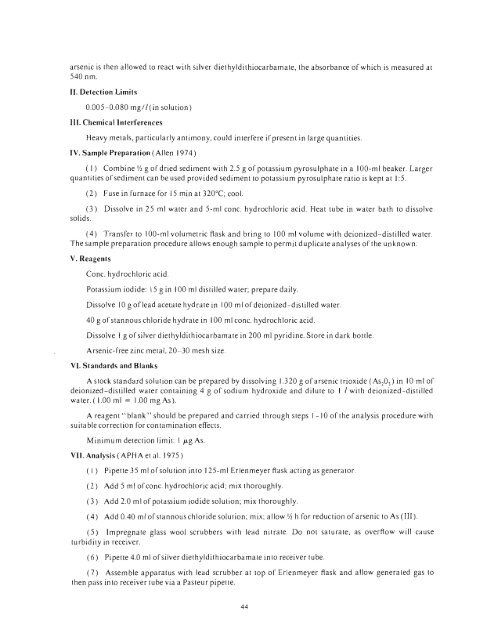Create successful ePaper yourself
Turn your PDF publications into a flip-book with our unique Google optimized e-Paper software.
arsenic is then allowed to react with silver diethyldithiocarbamate, the absorbance of which is measured at<br />
540 nm.<br />
II. Detection Limits<br />
0.005-0.080 mgl/( in solution)<br />
III. Chemical Interferences<br />
Heavy metals, particularly antimony, could interfere ifpresent in large quantities.<br />
IV. Sample Preparation (Allen 1974)<br />
( I) Combine 1/2 g of dried sediment with 2.5 g of potassium pyrosulphate in a 100-ml beaker. Larger<br />
quantities of sediment can be used provided sediment to potassium pyrosulphate ratio is kept at 1:5.<br />
(2) Fuse in furnace for 15 min at 320°C; cool.<br />
(3) Dissolve in 25 ml water and 5-ml conc. hydrochloric acid. Heat tube in water bath to dissolve<br />
solids.<br />
(4) Transfer to 1 OO-ml volumetric flask and bring to 100 ml volume with deionized - distilled water.<br />
The sample preparation procedure allows enough sample to permit duplicate analyses of the unknown.<br />
V. Reagents<br />
Conc. hydrochloric acid.<br />
Potassium iodide: 15 g in 100 ml distilled water; prepare daily.<br />
Dissolve 109 of lead acetate hydrate in 100 ml of deionized-distilled water.<br />
40 g of stannous chloride hydrate in 100 ml conc. hydrochloric acid .<br />
Dissolve 1 g of silver diethyldithiocarbama te in 200 ml pyridine. Store in dark bottle.<br />
Arsenic-free zinc metal, 20-30 mesh size.<br />
VI. Standards and Blanks<br />
A stock standard solution can be prepared by dissolving 1.320 g of arsenic trioxide (As z 0 3 ) in 10 ml of<br />
deionized-distilled water containing 4 g of sodium hydroxide and dilute to I / with deionized - distilled<br />
wa ter. ( 1.00 m I = 1.00 mg As).<br />
A reagent "blank" should be prepared and carried through steps 1-10 of the analysis procedure with<br />
suitable correction for contamination effects.<br />
Minimum detection limit: I J-Lg As.<br />
VII. Analysis (APHA et al. 1975)<br />
( I) Pipette 35 ml of solution into 125-ml Erlenmeyer flask acting as generator.<br />
(2) Add 5 ml ofconc. hydrochloric acid ; mix thoroughly.<br />
(3) Add 2.0 ml of potassium iodide solution; mix thoroughly.<br />
(4) Add OAO ml of stannous chloride solution; mix; allow Ih h for reduction of arsenic to As (III).<br />
(5) Impregnate glass wool scrubbers with lead nitrate. Do not saturate. as overflow will cause<br />
turbidity in receiver.<br />
(6) Pipette 4.0 ml of silver diethyldithiocarbamate into receiver tube.<br />
(7) Assemble apparatus with lead scrubber at top of Erlenmeyer flask and allow generated gas to<br />
then pass into receiver tube via a Pasteur pipette.<br />
44

















